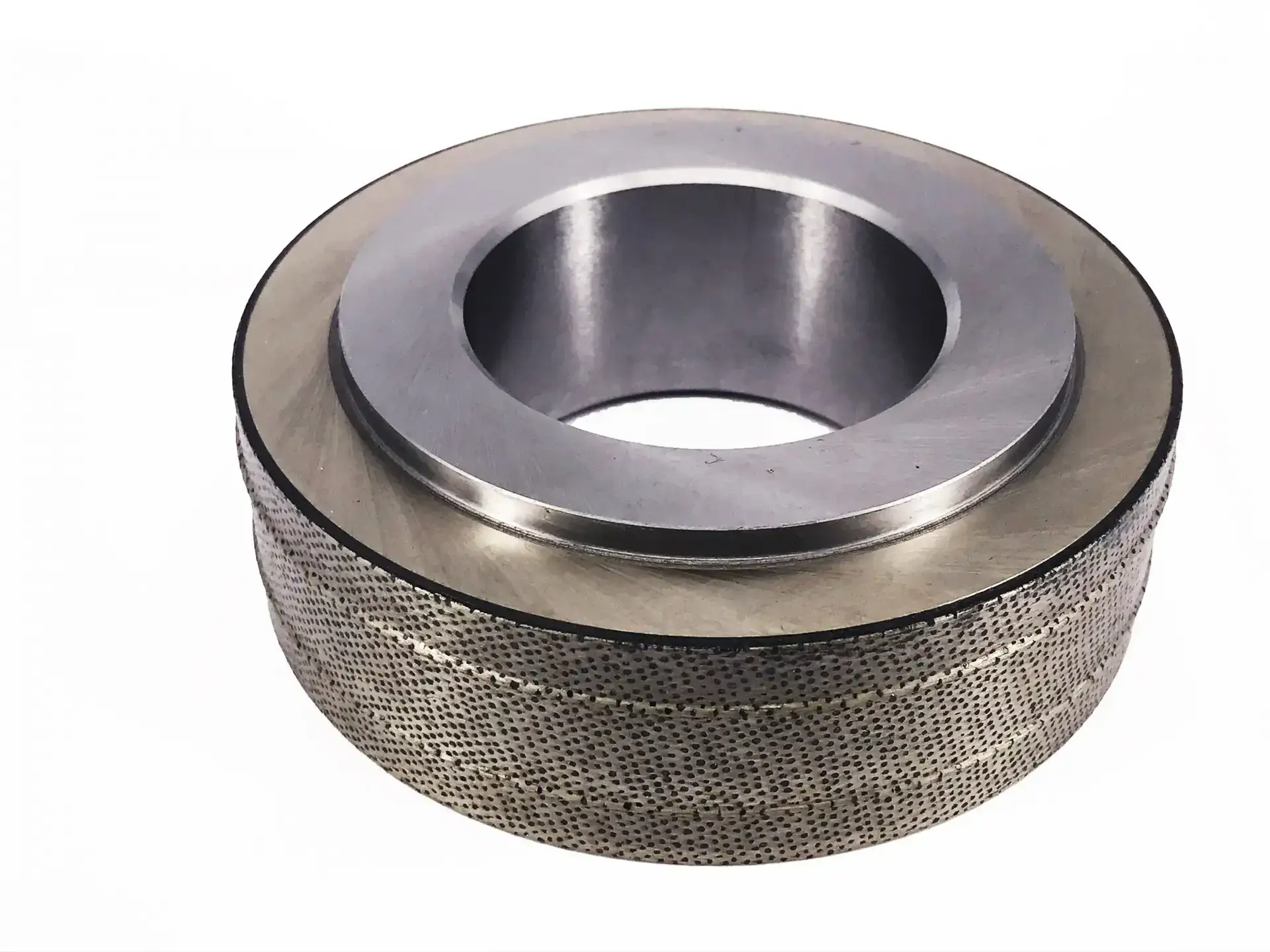In the field of precision machining, maintaining the shape of the grinding wheel is crucial. Choosing the appropriate diamond roller is essential for ensuring machining accuracy, tool life, and production efficiency. Different manufacturing processes, whether positive electroplating, reverse electroplating, or sintering, each have their unique advantages and applicable ranges.
Each process, based on its characteristics and the distribution of diamond particles, can meet the processing needs of different profiles, from high-precision, high-performance fine profile processing to applications requiring rough surfaces and high durability. Understanding the characteristics of these processes can help in selecting the optimal manufacturing solution, improving tool performance, and ensuring the machining quality of profiles to achieve the best production results.
This article will detail the characteristics and different application scenarios of these three processes: positive electroplating, reverse electroplating, and sintering, to provide readers with an in-depth understanding and enable them to choose the appropriate diamond grinding wheel method.
Table of Contents
Positive Electroplating
Positive electroplating (Electroforming) is a method of manufacturing metal parts or structures using electroplating technology. Its principle is to inject electricity into the roller through electrolytic deposition, and then attach diamonds to the substrate surface.
Diamond Arrangement
- Randomly Distributed Diamonds: Manufactured using the positive electroplating process, diamond particles are randomly distributed on the profile surface and fixed by electroplated nickel. The diamond particles are fixed on a single plane of the profile surface.
Features and Advantages
- Diamond particles vary in size, resulting in a rougher surface and strong erosive effect.
- Suitable for applications requiring high erosion and high roughness, but not suitable for high-precision applications.
- Can be recast multiple times, with lower cost and high manufacturing efficiency.
Reverse Electroplating
To electroform these types of tools using the reverse electroplating method, a metal negative mold with the reverse image of the dressing roller is first made. Then, electricity is injected into the negative mold. Diamond particles are attached to the substrate surface using reverse electroplating.
Diamond Arrangement
- Randomly Distributed Diamonds: Diamond particles are placed randomly on the substrate surface.
- Hand-Set Diamonds: Diamond particles are arranged by hand setting, with higher precision.
- Hand-Set/Randomly Distributed Diamonds: Combines hand setting and random distribution methods, offering both precision and flexibility.
Features and Advantages
- Reverse electroplating ensures precise distribution of diamond particles on the profile surface, allowing each abrasive grain to participate in the dressing process, improving dressing efficiency and tool life.
- Suitable for high-precision machining. These rollers can achieve extremely tight tolerances, especially suitable for fine profiles.
Sintering
Manufactured using the sintering process, diamond particles are mixed with a bonding agent and sintered into the roller base material under high pressure and high temperature.
Diamond Arrangement
- Randomly Distributed Diamonds: Diamond particles are randomly distributed on the profile surface.
Features and Advantages
- The coating thickness is larger, reaching several times the size of the diamond grains, with common thicknesses of 2mm, 3mm, or 5mm.
- Suitable for simple profile dressing with lower precision requirements, can maintain the original shape for a long time.
- Can be used to dress vitrified bond CBN grinding wheels.
- Can be occasionally sharpened to extend tool life.
- Often manufactured in the form of dressing rollers or cup shapes.
Sintering Process Steps
Dressing rollers manufactured using the sintering process involve the following steps:
- Mold Preparation: The prefabricated dressing roller body is installed in a die made of hot-work tool steel.
- Diamond Coating Filling: Diamond particles are mixed with a bonding agent and poured into the mold.
- High-Pressure Sintering: Compacted under high pressure and sintered into shape in a high-temperature environment.
- Cooling and Finishing: After cooling, the tool is finely machined to its final shape and the diamond grains are exposed.
Types of Diamond Abrasives Available for the Three Processes
| Process | Abrasive Type |
| Electroforming | Natural Diamond Synthetic Diamond |
| Reverse Electroplating | Natural Diamond Synthetic Diamond |
| Sintering | Natural Diamond Synthetic Diamond CVD (Chemical Vapor Deposition) |
How to Choose a Process
These three processes have different advantages and disadvantages, and are suitable for different applications. Choosing the correct process can improve the life of the diamond roller and ensure the quality of the profile.
| Process | Applicable Scenarios |
| Electroforming | ●High erosion and high roughness requirements ●Not suitable for high-precision applications |
| Reverse Electroplating | ●High-precision machining, fine profiles ●Suitable for situations where workpiece burning due to excessive grinding heat needs to be avoided |
| Sintering | ●Simple profiles with lower precision requirements ●Can maintain the original shape for a long time ●Suitable for dressing ceramic bond CBN grinding wheels ●Often manufactured in the form of dressing rollers or cup shapes |
We can draw the following conclusions based on the above scenarios
- High-precision and high-performance dressing (such as reverse electroplating) is suitable for fine profiles and high tolerance requirements.
- Rough surface requirements (such as positive electroplating) are suitable for highly erosive environments or rapid manufacturing.
- High durability and long-term use (such as sintering) are suitable for situations with lower precision requirements but require long-term maintenance.
Common Dressing Tools
Diamond Rollers>>Diamond Rollers
- Process: Reverse Electroplating, Sintering
- Introduction: Using diamond dressing rollers for grinding wheel profiling provides optimal solutions for process optimization, widely used in dressing formed grinding wheels with high-precision requirements (materials: aluminum oxide, silicon carbide, CBN grinding wheels, etc.).
- Suitable for: Precision components in industries such as bearings, ball screws, linear guides, gears, cutting tools and fixtures, automotive, and aerospace. Automated dressing operations that maintain grinding wheel shape accuracy during form or batch grinding processes.
Conclusion
Choosing the appropriate manufacturing process for diamond rollers is crucial for their performance and lifespan, depending on different machining needs. For high-precision and high-performance dressing, the reverse electroplating process is most suitable, especially for fine profiles and high tolerance requirements. For handling highly erosive environments or high roughness surfaces, the positive electroplating process offers a cost-effective solution. For situations with lower precision requirements and the need for long-term use, the sintering process is more suitable, providing stable performance. When processing special profiles, the reverse electroplating process offers accurate diamond grain placement, particularly suitable for high and narrow rib structures that cannot be electroplated. Selecting the appropriate process based on these needs can effectively improve tool performance and ensure profile machining quality.
Action
- Why does grinding generate heat?>>Grinding heat
- The basic knowledge of abrasives that must be known>>>Grinding-Abrasive Introduction
- The Key Role of Grinding Wheel Performance>>Bond
- Whether the current measured surface roughness meets your expected goals>>>Comparison Chart of Grinding Polishing and Surface Roughness
- Various aspects of grinding wheel abrasive grains>>The Grinding Effect of the Grinding Wheel Particles
- What to do if the surface is deteriorated>>In-depth analysis of grinding to avoid surface deterioration
- The surface is not rough, the light is not smooth>>What is surface roughness?
- Different grinding states of cutting edge>>In-depth understanding of grinding wheel cutting edge shapes, variations, and self-sharpening mechanisms
- Action>>>Diamond and CBN grinding wheel, Polishing abrasive, Polishing Equipment, Polishing Tools
- Review
We offer customized adjustments to the grinding process, tailored to meet processing requirements for maximum efficiency.
After reading the content, if you still don’t know how to select the most suitable option,
Feel free to contact us and we will have specialist available to answer your questions.
If you need customized quotations, you’re also welcome to contact us.
Customer Service Hours: Monday to Friday 09:00~18:00 (GMT+8)
Phone: +8867 223 1058
If you have a subject that you want to know or a phone call that is not clear, you are welcome to send a private message to Facebook~~
Honway Facebook: https://www.facebook.com/honwaygroup
You may be interested in…


